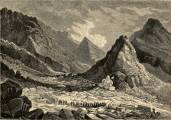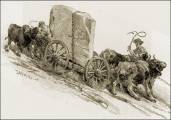


Tulare County
- Tulare County – List of Stone Quarries, Etc.
- Tulare County Granite Resources circa 1913 – Included in chapter in “California,” by G. F. Loughlin, in the Mineral Resources of the United States Calendar Year 1913, Part II. Nonmetals, United States Geological Survey, 1914.
- Tulare County Mines and Mineral Resources (circa 1915-1916) – Excerpts from Report XV of the State Mineralogist, Mines and Mineral Resources of Portions of California, Chapters of State Mineralogist’s Report Biennial Period 1915-1916, Part VI. San Bernardino County and Tulare County, California State Mining Bureau, 1919.
- Tulare County Mineral Industry (circa 1917) − Mines and Mineral Resources of San Bernardino County and Tulare County, California State Mining Bureau, San Francisco, 1917, pp. 126-180.
- Tulare County Mineral Industry (circa 1919) – Excerpt from California Mineral Production for 1919, Bulletin No. 88, by Walter W. Bradley, California State Mining Bureau, 1920.
- Tulare County Limestone Industry and Deposits (through 1947) – Excerpts from “Limestone in California,” by Clarence A. Logan, California Journal of Mines and Geology, Vol. 43, No. 3, July 1947, California Division of Mines, San Francisco, California.
- Present day – “Mineral Resources of Tulare County,” the County of Tulare web site.
- Tulare County Mines and Mineral Resources (circa 1915-1916) – Excerpts from Report XV of the State Mineralogist, Mines and Mineral Resources of Portions of California, Chapters of State Mineralogist’s Report Biennial Period 1915-1916, Part VI. San Bernardino County and Tulare County, California State Mining Bureau, 1919, pp. 775-954. (Used with permission, California Department of Conservation, California Geological Survey.)
Tulare County, by W. Burling Tucker, Field Assistant. Field work in June, 1916.
Description
“Tulare County, one of the largest counties of the San Joaquin Valley, is bounded on the northwest and north by Fresno, on the east by Inyo, on the south by Kern, on the west by Kings County. It has an area of 4856 square miles. The eastern half of the county lies in the Sierra Nevada. The western half extends across the San Joaquin Valley, and is fairly level, except a small portion in the extreme west which extends into the Coast Range. The eastern boundary of the county commencing at the crest of the Sierras embraces Mount Whitney, which is the highest peak in the United States, with an altitude of 14,501’….”
Railroad Facilities (in Tulare County)
“The county is traversed by both the Southern Pacific and Santa Fe systems with their main lines and branches. The Visalia Electric Railroad is in operation between Visalia and Redbans, via Farmersville, Exeter and Lemon Cove.
Mining Conditions (in Tulare County)
“Tulare County continues to be the most important source of magnesite in this country. On account of the difficulty in securing imports of magnesite from European countries, the demand for California magnesite has been very active during 1915 and 1916, the result being that there has been a great revival in mining this mineral, and a large tonnage is being shipped from Porterville, Lindsay, and Exeter.
“There has also been a renewal of mining activity in the Mineral King and White River districts.”
Mineral Resources (in Tulare County)
“Tulare County’s mineral resources consist of asbestos, brick, clay, chromite, copper, feldspar, gold, graphite, gems, infusorial earth, lead, limestone, magnesite, marble, natural gas, quartz, glass sand, and silver, soapstone, miscellaneous stone, and zinc.”
Granite (in Tulare County)
“In the foothills east of Porterville and Exeter there are extensive deposits of biotite-granite, which are suitable for building purposes. Up to the present time (circa 1916) only a small amount of development has been done on these deposits.
Limestone (in Tulare County)
“There are extensive deposits of limestone in the foothills and mountainous regions in the eastern part of the county. On the North and South forks of the Tule River there are large belts of limestone which have general northwesterly and southeasterly strike. Extensive deposits of limestone occur in the neighborhood of Three Rivers, and on the Middle, Marble and South forks of the Kaweah River in the Sequoia National Park.
“In the Mineral King District at the White Chief mine there is an extensive deposit of crystalline limestone.”
- Tulare County Mineral Industry (circa 1919) – Excerpt from California Mineral Production for 1919, Bulletin No. 88, by Walter W. Bradley, California State Mining Bureau, 1920, pp. 169-170.
Area: 4,856 square miles.
Population: 59,031 (1920 census).
Location: Bounded by Inyo on the east, Kern on the south, Fresno on the north.“Tulare stands thirty-second on the list of mineral-producing counties, the drop from the 1918 value being due to magnesite. This county’s mineral resources, among others, are: Brick, clay, copper, feldspar, graphite, gems, limestone, magnesite, marble, quartz, glass-sand, soapstone, miscellaneous stone, and zinc. Tulare for a number of years has led the state in magnesite output, except in 1918, when it was passed by Napa County.
“Commercial production for 1919 was as follows:
(Headings for the information below are: Substance, Amount, and Value.)
Brick and tile, —, $34,978
Limestone, 10,347 tons, $46,388
Magnesite, 18,765 tons, $186,601
Natural gas, 700 M. cu. ft, $295
Stone, miscellaneous, ---, $10,811
Other minerals,* ---, $51,928
(Total value) $51,928
(* Includes chromite, feldspar, and granite.)
- Tulare County Limestone Industry and Deposits (through 1947) – Excerpts from “Limestone in California,” by Clarence A. Logan, California Journal of Mines and Geology, Vol. 43, No. 3, July 1947, California Division of Mines, San Francisco, California, pp. 175-357. Used with permission, California Department of Conservation, California Geological Survey.)
“Situated about midway between the population centers of San Francisco Bay and the Los Angeles area, and lying partly in the rich and well populated San Joaquin Valley, Tulare County has large deposits of limestone within reasonable distances of existing railroads. It could supply the valley territory from Merced to Bakersfield. At present, there is no active limestone property in the county, although at one time three deposits were worked. The use of limestone in Tulare County for soil treatment has apparently ceased, while gypsum and fertilizers are widely applied. A sugar refinery, now idle, once used local limestone and some ground limestone was also marketed for use in oil-well mud.
“Part of Tulare County north and east of Three Rivers, is in Sequoia National Park, and no limestone deposits have been visited inside the park boundaries (although such deposits do occur there), as mining is not generally allowed in such parks, except upon land that was already privately owned at the time the park was established. Several of the limestone deposits within the boundaries of this park are indicated on the map showing the locations of deposits in the county, and it will be noted that in general those within the park are farther from railroad than the many privately owned deposits in other parts of the county.
“Most of the deposits seen are roof pendants, more or less altered by contact metamorphism especially in their lower sections. In some cases the metamorphism has been extensive enough to make selective mining necessary. The county has been subjected to a long period of erosion, during which the sedimentary and metamorphic rocks, including limestone and marble, have been in large part removed, leaving residual deposits, typically covering hills or mountains of granitic rock, and pierced in their basal secretions by a great variety of intrusives, ranging in composition from ultra-basic or lamprophyric rocks to aplite which represent the later stages of the great Sierra Nevada batholith.
“Cordell Durrell (40, 43)* has discussed the geology of a small part of the county, in the vicinity of Lemon Cove and Three Rivers and Jenkins (43)** has described tungsten mines and prospects in the same region. Although these tungsten occurrences are associated with limestone, and may have possible commercial value, they are mostly so far from railroads that the limestone could not be marketed at a profit. The limestone bodies with scheelite are also often too small to be of interest to possible users….”
(* Cordell Durrell, “Geology of the Sierra Nevada Northeast of Visalia, Tulare County, California,” California Journal of Mines and Geology, vol. 39, pp. 153-168, pl. 3, 1943.)
(** William O. Jenkins, “Tungsten Deposits Northeast of Visalia, California,” California Division of Mines Report 39, pp. 169-182, 3 figs., 1943.)
“The geology of much of the county has not been shown on the state geologic map. Although the eastern portion is a part of the Sierra Nevada, the limestone occurrences differ from those in the Mother Lode counties. They are in part Triassic and in part Paleozoic, and do not show the uniformity in character or in degree of metamorphism that is noted farther north. This may be due to the fact that in Tulare County the surrounding rocks have been less resistant to erosion so that denudation of the batholith of the Sierra Nevada has proceeded far enough to expose contact zones not yet uncovered in the Mother Lode region.”
Commercial use of material within this site is strictly prohibited. It is not to be captured, reworked, and placed inside another web site ©. All rights reserved. Peggy B. and George (Pat) Perazzo (deceased).
